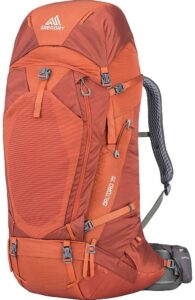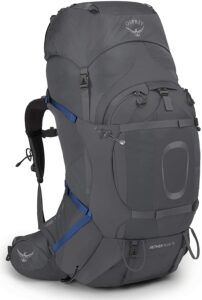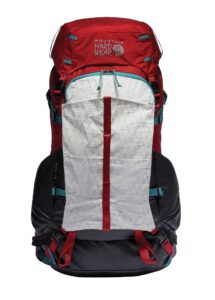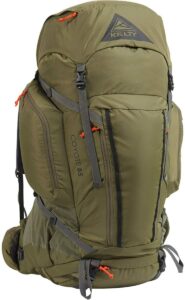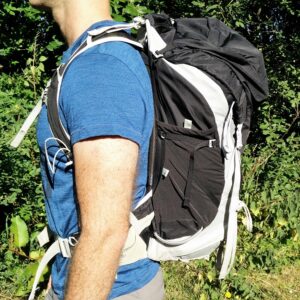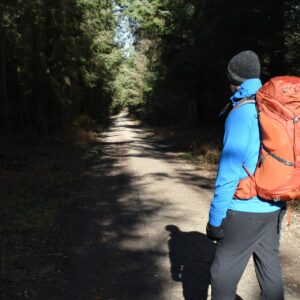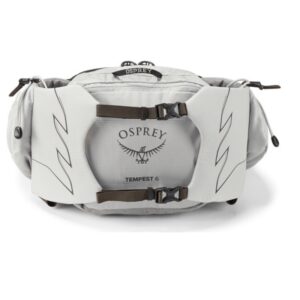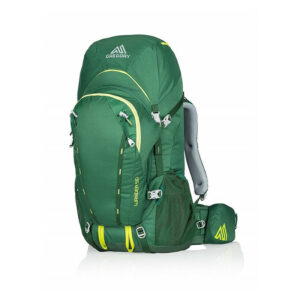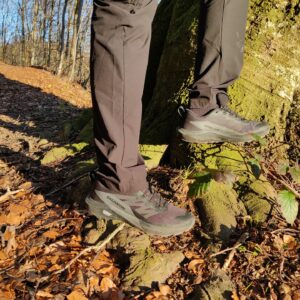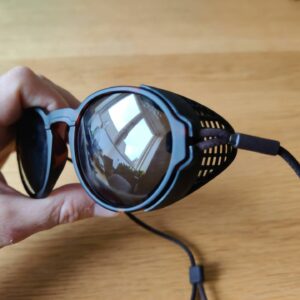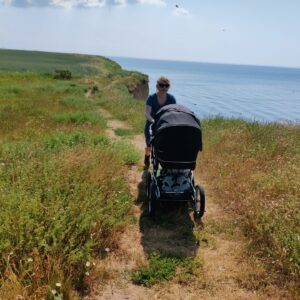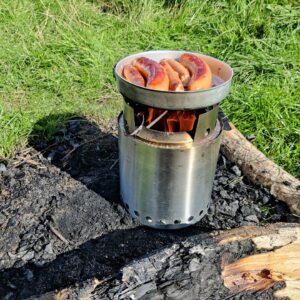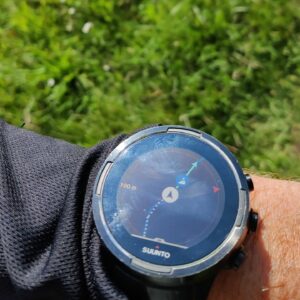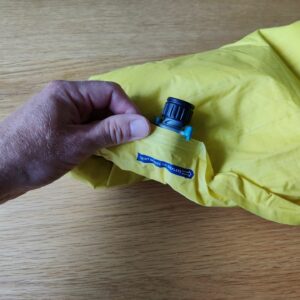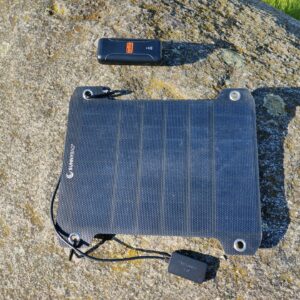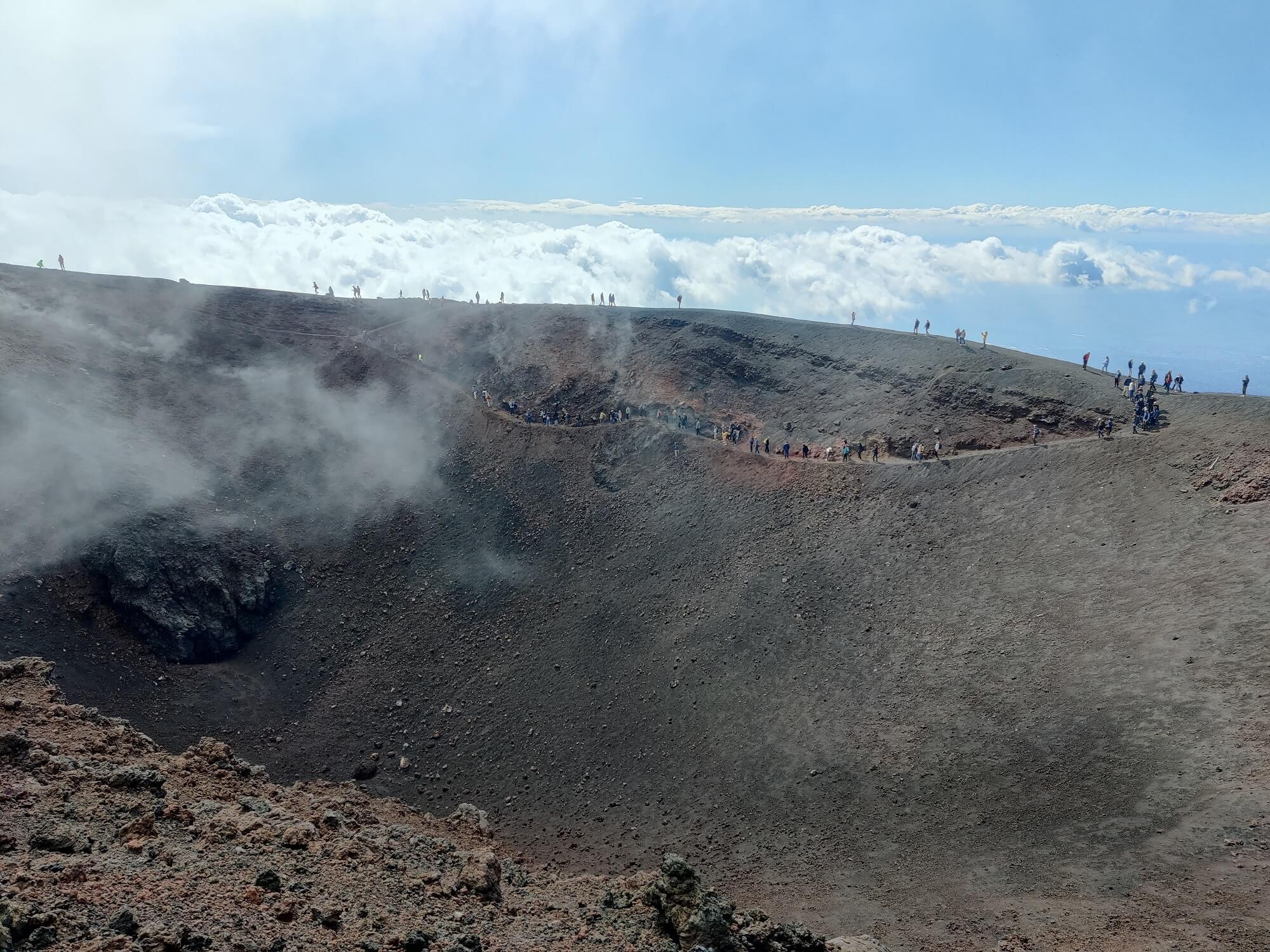Here we selected and reviewed the best expedition backpacks with a capacity of 70 liters or more. Such backpacks offer enough storage space for expeditions lasting more than five days. However, be aware that the required capacity of a backpack greatly depends on the equipment and supplies that you need/want to carry with you. For example, winter trips require additional equipment such as crampons, gaiters, insulated clothing etc. and thus also a bigger backpack. Nevertheless, a backpack should be sufficiently packed/filled to remain stable on your back and therefore the backpacks listed here might be too big for shorter trips. To learn more about how to properly pack a backpack for stability and comfort check out our article How to pack a backpack. The backpacks in this review are, however, perfect for extended trips of five days or more (backpacking, trekking, expeditions etc.) which require a lot of supplies (water, food etc.) and equipment (sleeping equipment, cooking equipment etc.). Due to their storage capacity and pockets, they are also perfect for travelling.
For in-depth information about how to choose the right backpack for your needs check out our Backpacks Guide.
Updated Content
We regularly update our reviews and selections to always recommend you the best products on the market.
Expert Selections
We only list top-tier products. Read how our selections of best hiking products differ from others here.
Links
We use affiliate links and may receive a small commission on purchases at no extra cost to you.
1. Our Expedition Backpack Picks
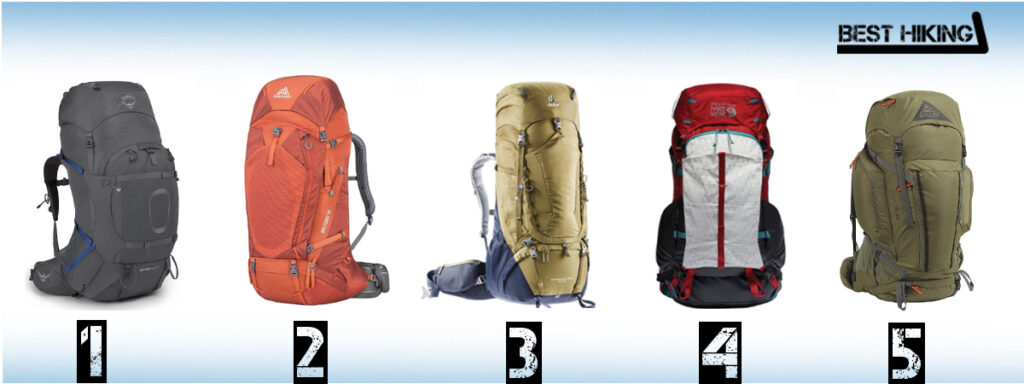
Best expedition backpacks
- Osprey Aether Plus 70
- Gregory Baltoro 75
- Deuter AirContact Pro 70+15
- Mountain Hardwear AMG 75
- Kelty Coyote 85
2. Comparison of Expedition Backpacks
| Feature/Product | Osprey Aether Plus 70 | Gregory Baltoro 75 | Deuter AirContact Pro 70+15 | Mountain Hardwear AMG 70 | Kelty Coyote 85 |
|---|---|---|---|---|---|
| Weight | 5 lbs. 9 oz. | 5 lbs. 4 oz. (L) | 6 lbs. 14 oz. | 4 lbs. 15.4 oz. (M/L) | 4 lbs. 14 oz. |
| Weight (Metric) | 2540 g | 2370 g (L) | 3130 g | 2250 g (M/L) | 2210 g |
| Sizes | S/M, L/XL | S, M, L | One Size | S/M, M/L | One Size |
| Frame | Internal | Internal | Internal | Internal | Internal |
| Fits Torso | 16-20 in. (S/M); 19-23 in. (L/XL) | 16-18 in. (S); 18-20 in. (M); 20-22 in. (L) | 16.5 – 24.5 in | 16-19 in. (S/M); 18-21 in. (M/L) | 15.5 – 21 in. |
| Fits Torso (Metric) | 40.5-51 cm (S/M); 48-58.5 cm (L/XL) | 41-46 cm (S); 46-51 cm (M); 51-56 cm (L) | 42 – 62 cm | 41-48 cm (S/M); 46-53cm (M/L) | 39– 53 cm |
| Material | Nylon | Nylon | Nylon/Polyester | Nylon | Polyester |
| Volume | 68 (S/M); 70 (L/XL) | 71 (S); 75 (M); 79 (L) | 70 + 15 | 75 (S/M); 78 (M/L) | 85 |
| Backpanel | AirScape | Response A3 | AirContact Pro | n/a | AMP-Flow |
| Hip Belt | Yes | Yes | Yes | Yes | Yes |
| Sternum Strap | Yes | Yes | Yes | Yes | Yes |
3. The Selection
1. Osprey Aether Plus 70
Suitable for:
- Hiking
- Mountaineering
- Expeditions
- Backpacking
- Travelling
The Osprey Aether Plus 70 backpack is perfect for expeditions because it provides great functionality while it is super light (it weighs merely 5 lbs. 9 oz.). The body of the backpack is made of durable nylon while the shoulder straps and the hip belt are made of thick foam for comfortable carrying. Due to the AirScape suspension, the backpack is perfect for carrying heavy loads. The AirScape suspension efficiently transfers the weight from the shoulders to the hips via the custom fit hip belt. The padding on the hip belt can be shortened or extended for perfect fit. The backpanel is covered with a suspended mesh fabric for good breathability and comfort. The Osprey Aether Plus 70 features a spacious main compartment, multiple lid pockets, two side pockets, two hip belt pockets, a front stash pocket and an internal sleeve for hydration bladder. The main compartment can be accessed from the top as well as through the zipper that goes all around the front side of the backpack. Therefore, you can easily get things out of the main compartment even when the backpack is fully loaded. The lid can be removed and doubles as a day pack which comes in handy on long hikes – you can, for example, leave the backpack in the camp and go for a day hike carrying only the lightweight daypack. When the lid is removed the top of the backpack can be protected with the FlapJacket top cover (a piece of fabric that goes over the top of the backpack). Therefore, you can also leave the lid at home if you don’t need the extra storage space. The Osprey Aether Plus 70 also features an integrated rain cover, side compression straps, front compression straps, trekking poles attachment system and ice axe loops.
Women's Version: Available - Osprey Ariel Plus 70
Note: Women's version might slightly differ from the men's version.
Pros:
- Main compartment access
- Lid doubles as a daypack
- Weight
- IsoForm hip belt
- Back system
- Durable materials and construction
- Integrated rain cover for protection in wet conditions
Cons:
- Relatively high price point
- Some users may find it a bit heavy for ultralight backpacking
Video

2. Gregory Baltoro 75
Suitable for:
- Hiking
- Mountaineering
- Expeditions
- Backpacking
- Travelling
The Gregory Baltoro 75 is another top-quality expedition backpack. It is slightly bigger than the Osprey Aether 70 mentioned above but even lighter. The backpack features the advanced A3 (Automatic Angle Adjust) back system which adapts to your body and maintains your center of gravity. Due to the A3 back system, the backpack also efficiently transfers the weight from the shoulders to the hips via the hip belt. It uses an ergonomically shaped hip belt which rotates for better fit (a so-called pivoting hip belt). The backpanel is padded and has a ventilation channel in the middle in order to provide good breathability. A plate made of EVA foam is inserted under the backpanel for cushioning but it can be removed in case that it’s not required. The backpack has a main compartment, one internal lid pocket, two external lid pockets, two large side zippered pockets, a large front zippered pocket, two hip belt pockets and a water bottle pocket on the side. Similar to the Osprey backpack mentioned above, the main compartment of the Baltoro backpack can be accessed from the top, bottom and front. The right hip belt pocket is waterproof and thus perfect for storing a GPS device or phone. The backpack also features an internal sleeve for hydration bladder which doubles as a lightweight daypack. The Gregory Baltoro 75 backpack is available in three sizes which differ in backpanel length and overall capacity.
Women's Version: Available - Gregory Deva 70
Note: Women's version might slightly differ from the men's version.
Pros:
- Main compartment access
- Hydration bladder sleeve doubles as a daypack
- Weight
- Rotating hip belt
- Back system
- Main compartment access
Cons:
- Price may be a limiting factor for some
Where to buy?
Also available at:
Video

3. Deuter AirContact Pro 70+15
Suitable for:
- Hiking
- Mountaineering
- Expeditions
- Backpacking
- Travelling
The Deuter AirContact Pro 70+15 is an extremely durable expedition backpack which provides great functionality. However, with the weight of 7 lbs. it is also the heaviest backpack in this review. The body of the backpack is made of 600-denier polyester while the areas exposed to abrasion are made of durable 330-denier nylon. Both materials are coated with polyurethane for better water resistance. The backpack features the AirContact Pro back system which has two aluminum stays for good stability when you are carrying heavy loads. The shoulder straps and hip belt are anatomically shaped and well-padded to provide good comfort. Like the Gregory Baltoro 75, the Deuter AirContact Pro 70+15 features a rotating hip belt for good fit. The backpanel is padded with foam and has an air channel in the middle for increased breathability and comfort. The backpack features a main compartment, external lid pocket, internal lid pocket, two zippered side pockets, two side mesh pockets, front stash pocket and a hip belt pocket. The main compartment can be accessed from the top, bottom and front. The zippered side pocket is designed to fit a hydration bladder with a volume up to 3 liters. The backpack also has attachment points for trekking poles and ice axes. It comes with a rain cover. The Deuter AirContact Pro 70+15 backpack is only available in one size but it does have a fully adjustable back system which ensures perfect fit for most people. It has a capacity of 70 liters but it can be extended for 15 liters by rolling the top collar up and extending the lid straps.
Women's Version: Available - Deuter AirContact Pro 65+15
Note: Women's version might slightly differ from the men's version.
Pros:
- Main compartment access
- Rotating hip belt
- Back system
- AirContact Pro back system for excellent load distribution and ventilation
- Integrated rain cove
Cons:
- Relatively heavy for some users
- Hydration bladder goes in the side pocket (has to be balanced out with a counterweight)
Where to buy?
Also available at:
4. Mountain Hardwear AMG 75
Suitable for:
- Hiking
- Mountaineering
- Ski touring
- Expeditions
- Backpacking
The Mountain Hardwear AMG 75 backpack is the result of the brand’s year-long research and cooperation with mountain guides and athletes to make the optimal expedition pack. It is made of 200D ripstop nylon, but the bottom, external pockets and other areas prone abrasion are made of 840-denier nylon with a carbonated surface. The white crampon pocket on the front of the pack is made with the even stronger Dimension Polyant DX40, so you can safely carry crampons, ice axes etc. in it. Behind the crampon pocket, there is a zippered pocket with internal sleeves designed to accommodate a probe and a snow shovel, but you can of course fill it with whichever equipment you are bringing. The water bottle pockets on the sides can be expanded by loosening the pockets’ compression straps accordingly in order to carry bulkier items. The compression straps on the front and sides are connected so you can place and secure bulky items like a tent, sleeping pad etc. wherever it suits you. There are two zippered pockets (one with weather flap) on top of the lid for easy access, and also a small zippered pocket on the inside of the lid, which is fully removable. The Mountain Hardwear AMG 75 backpack is hydration-compatible, with the sleeve separate from the main compartment – which can only be accessed from the top. The (rotating and removable) hipbelt, shoulder straps and top of the backpanel are thickly padded for comfort when carrying a heavy load. The AMG 75 backpack comes in two torso sizes, but can adjusted further for additional comfort and fit.
Women’s Version: No – this product is unisex and can thus be used by all. Be aware of sizing, though.
Pros:
- Rotating hip belt
- Multiple attachment points (loops, compression straps) for tools and additional gear
- Durability
- Main compartment can be overloaded if you loosen the inner cinch cord
Cons:
- Main compartment access
- Limited availability compared to more mainstream brands
- May not have as many organizational features as other packs
Also available at:
Video

5. Kelty Coyote 85
Suitable for:
- Hiking
- Mountaineering
- Expeditions
- Backpacking
- Travelling
The Kelty Coyote 85 is the most spacious expedition backpack in this review – it has a capacity of 85 liters. The backpack provides great durability as it is made of 420-denier polyester. The hip belt, shoulder straps and backpanel are made of breathable foam and thus they provide good comfort and breathability. The backpack uses the FIT-Pro back system which is designed for carrying heavy loads. The FIT-Pro back system features one aluminum stay which efficiently transfers the weight from the shoulders to the hips. The backpack has a main compartment, external lid pocket, internal lid pocket, two zippered side pockets, two front zippered pockets, a front stash pocket and two hip belt pockets. The main compartment can be accessed from the top and the bottom. The backpack also features trekking pole attachment system and a pocket for hydration system. It comes only in one size but as it has a fully adjustable suspension system, it fits most people.
Women’s Version: No – this product is unisex and can thus be used by all. Be aware of fitting it properly, though.
Pros:
- Main compartment access
- Back system
- Multiple pockets for organization
- Solid construction and durability
Cons:
- Limited ventilation on the back panel
Where to buy?
Also available at:
Video

4. Expedition Backpack Buying Advice – What is important?
Frame and Hip Belt:
All backpacks in this review have an internal frame so that they transfer the weight from the shoulders to the hips via the hip belt. Carrying a heavy backpack is much easier if the weight is efficiently transferred to the hips as the hips are supported by larger muscle groups than the shoulders. A study from Murdoch university in Australia concluded that hip belt increases level of stability and decreases level of exertion.
Fit:
The backpack must match your torso length so that it sits comfortably on your back. Your torso length is the distance between the bony bump at the base of your neck and the tops of your hipbones (learn how to measure your torso length in the fit section of our Hiking Backpacks Guide). In the comparison table above, we have listed the respective torso length(s) which each backpack fits. It is also important to adjust the backpack correctly. Learn how to adjust the backpack in our article How to fit a backpack.
Backpanel:
The backpanel is a very important part of the backpack as it provides ventilation so that the sweat from your back can evaporate, rather than seeping through your clothes and the backpack. The expedition backpacks in this review feature ergonomically shaped ventilated backpanels. Some also include a suspended mesh fabric which creates a distance between your back and the backpack to allow the air to flow in between. Such a construction provides especially good ventilation.
Weight:
Lightweight equipment decreases the aerobic demand (heart rate, calorie consumption etc.), and thus allows you to hike faster and easier than with heavier gear. As backpacks are not among the lightest pieces of hiking gear, a lightweight backpack makes a big difference. In this selection we only included lightweight expedition backpacks (in terms of weight to capacity ratio) – the heaviest expedition backpack on this list weighs around 7 pounds (3 kg). Read more about why it is important to use lightweight gear for hiking in our article Why hike lightweight.
Pockets and attachment points:
In addition to the main compartment, an expedition backpack with a capacity of more than 70 liters should also have well-placed and easily accessible pockets/compartments. Pockets and compartments allow you to organize your gear so that you can easily and quickly find important items. All backpacks in this review are also equipped with attachment points (for hiking poles, ice axes, helmet etc.).
Hydration System Compatibility:
A hydration system allows you to hydrate without having to take off your backpack to get to the water bottles. To learn more about the advantages and disadvantages of hydration systems please read our article Hydration Systems VS. Water Bottles. If you don’t already have a hydration bladder, check out our review of the Best Hydration Bladders.
